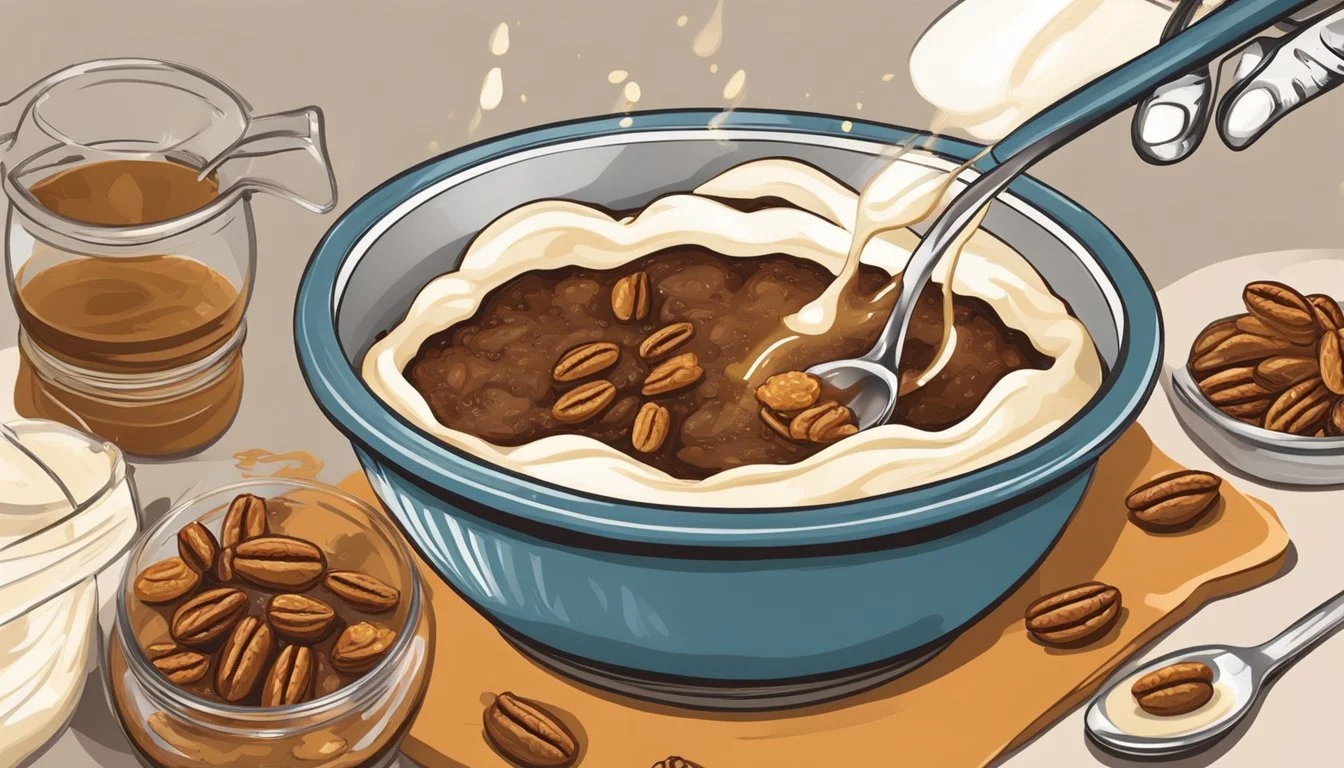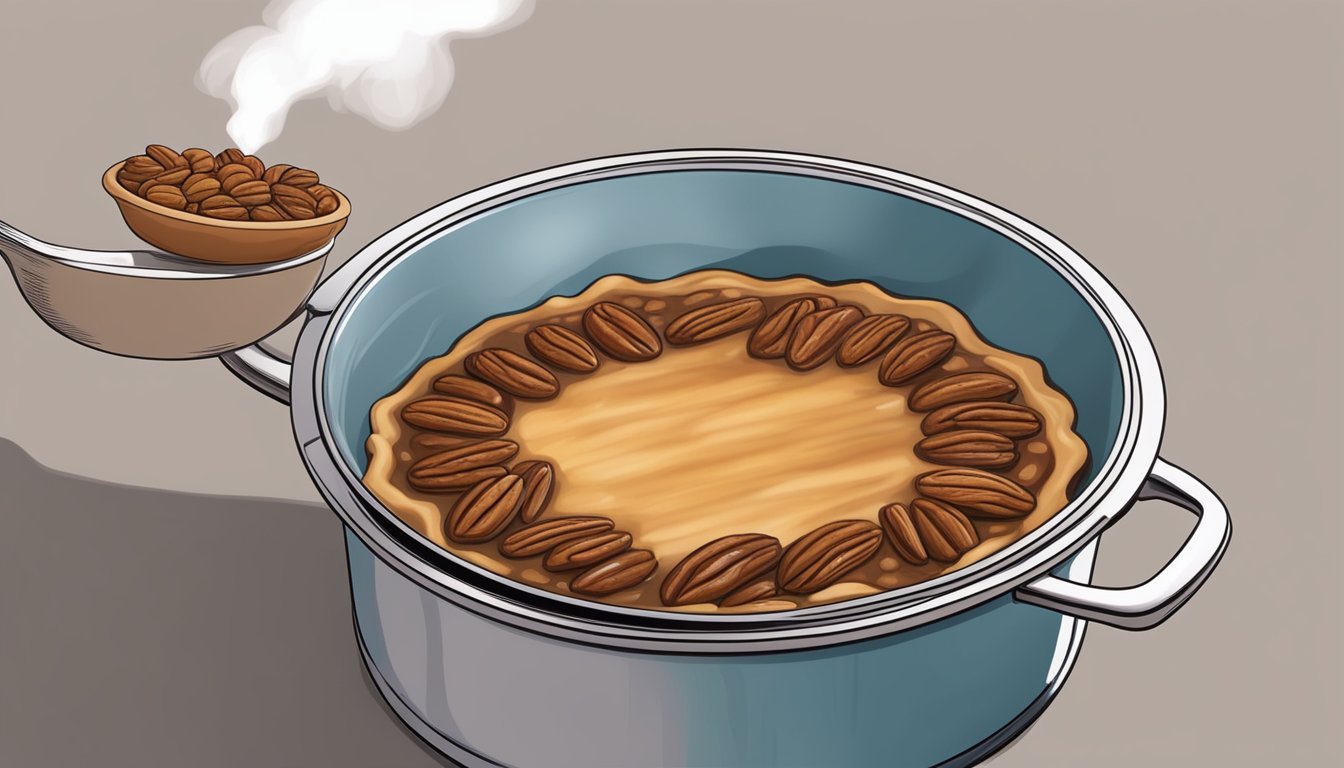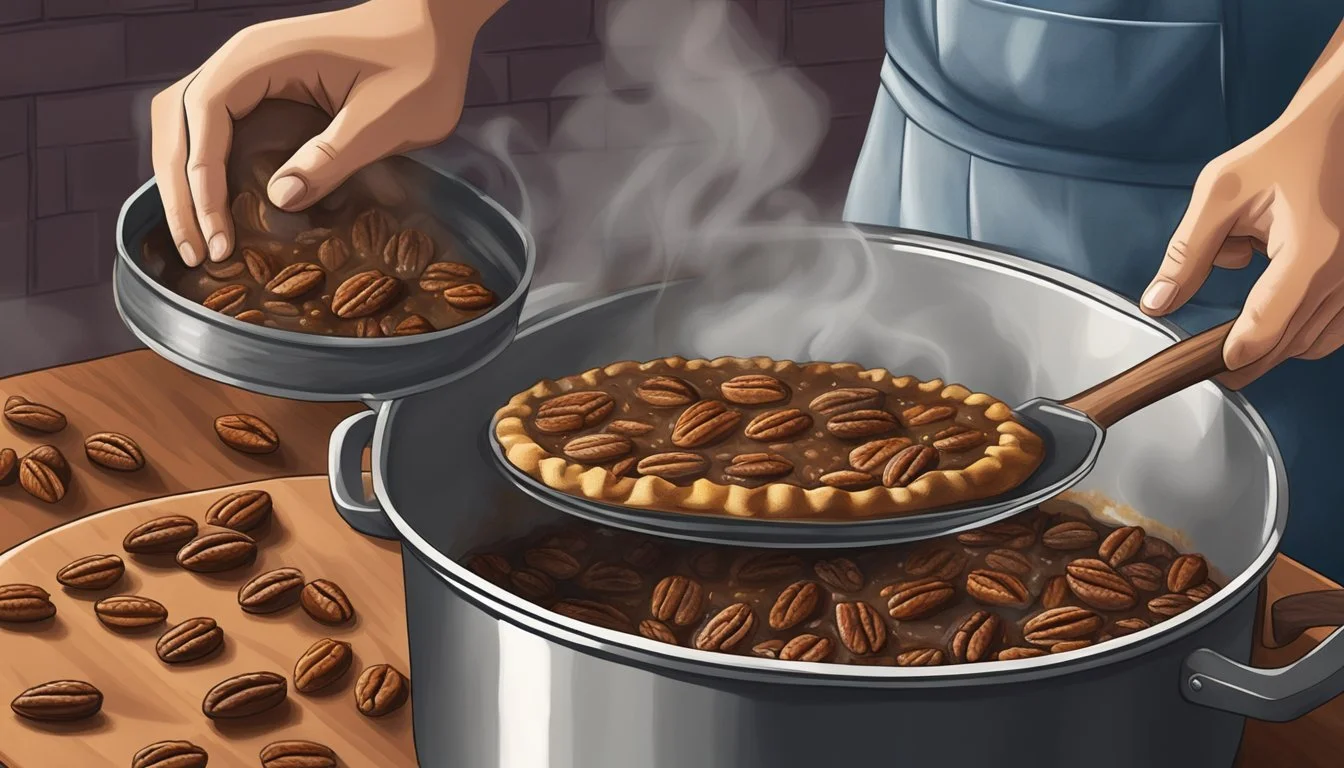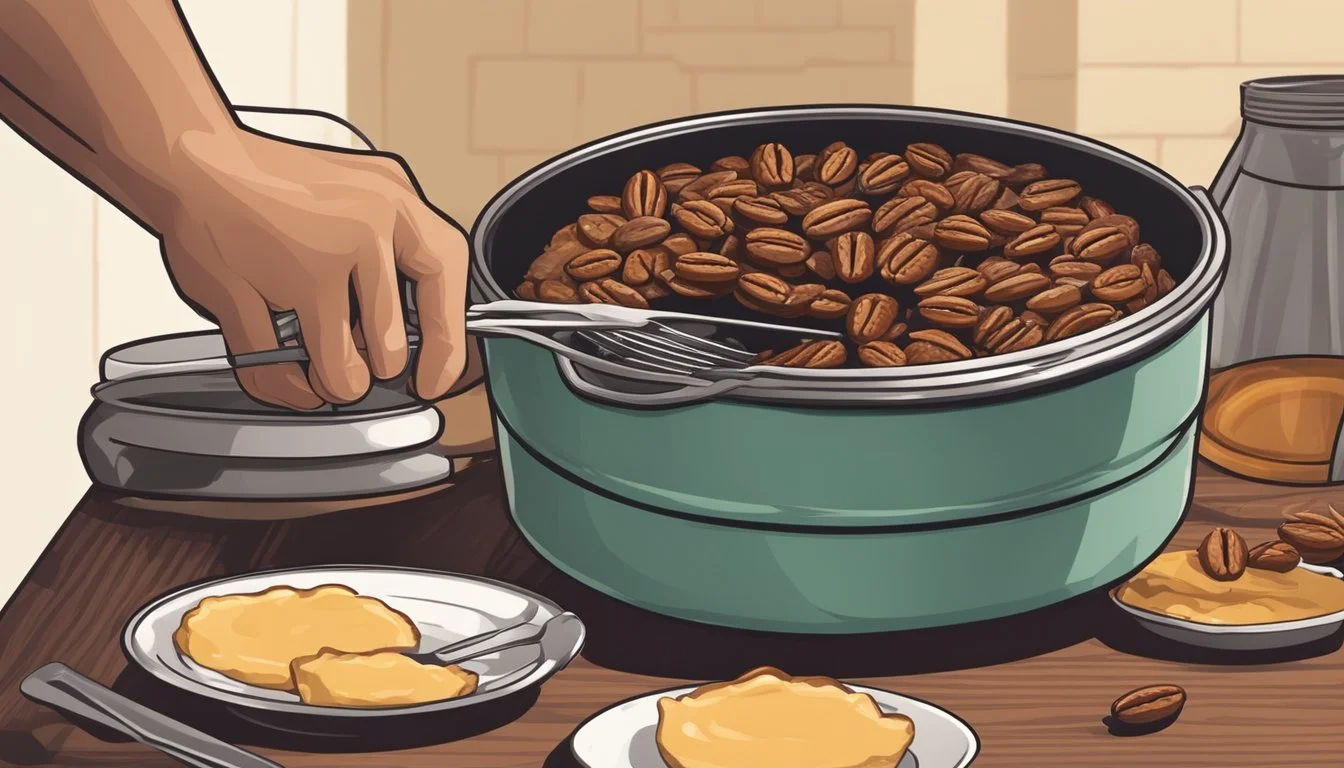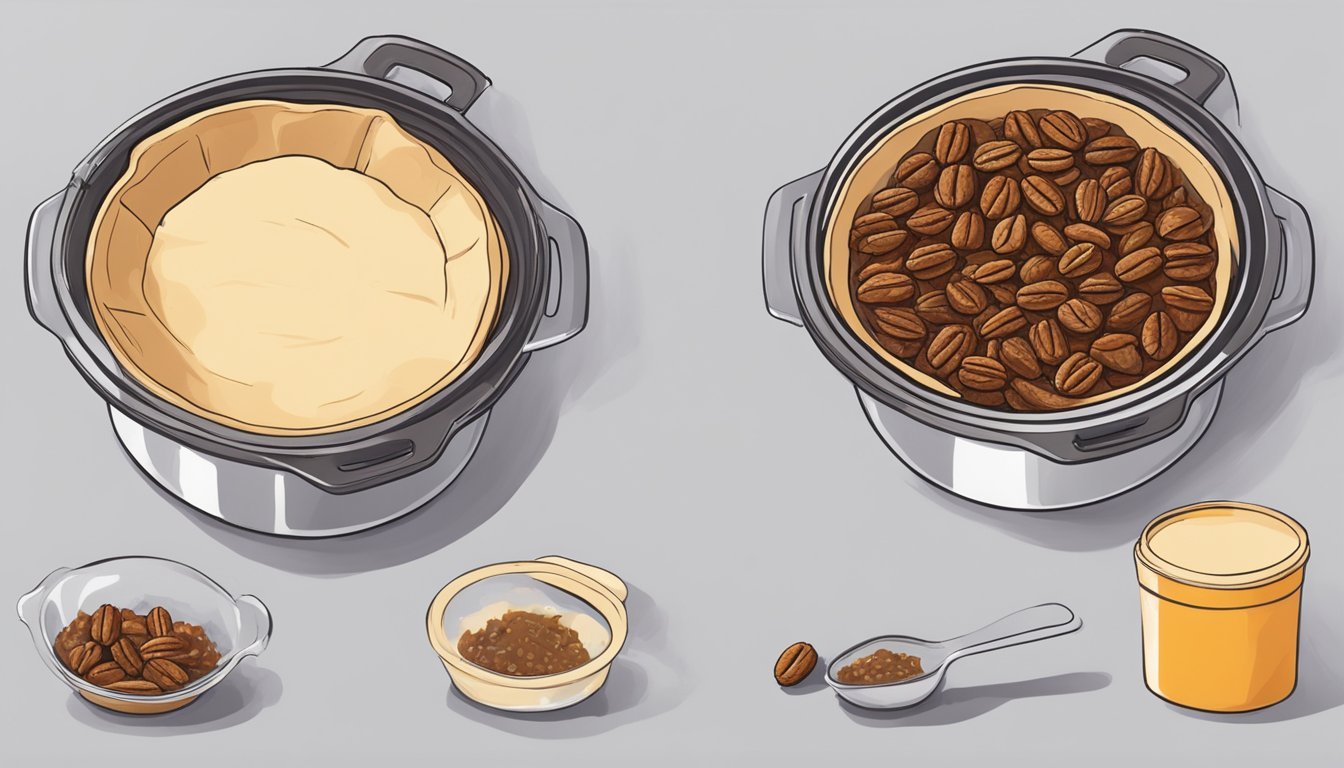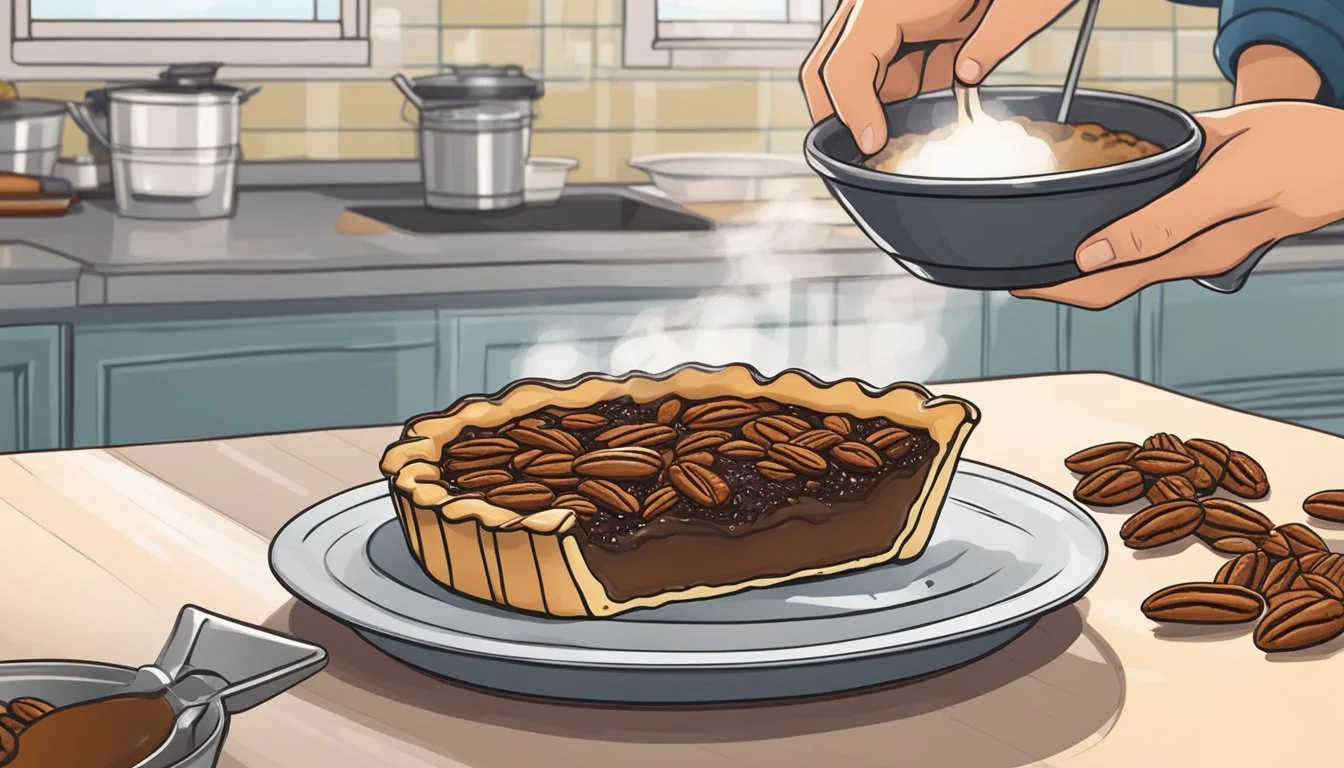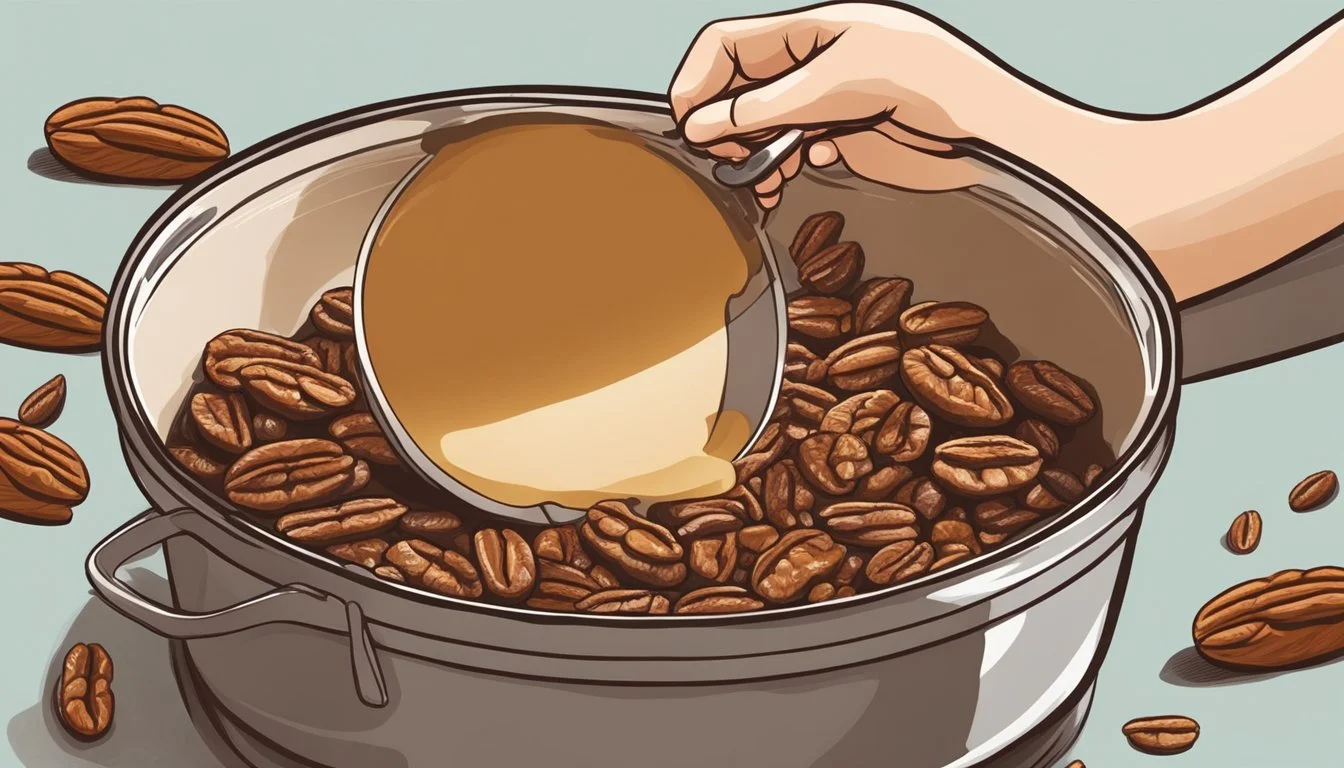Saving Burnt Pecan Pie Filling
Expert Tips for Restoring Flavor Balance
The Thanksgiving feast is a hallmark of communal joy and culinary pride, often culminating in a parade of desserts with pecan pie holding a place of honor. However, even seasoned bakers can encounter mishaps like burnt pecan pie filling. The key to saving a burnt pie lies not just in masking the error, but in carefully removing the bitterness to restore its delightful nuttiness. The process requires a gentle yet strategic approach to ensure that the pie retains as much of its original flavor and texture as possible, without the burnt taste.
Addressing burnt pecan pie filling involves a combination of removal and enhancement. Since the bitterness is concentrated in the charred parts of the filling, they must be identified and scraped away carefully. Following this, adjustments can be made to the remaining filling to balance the flavors, with the addition of certain ingredients that complement the natural richness of pecans. This may include a bit more corn syrup or sugar, a dash of vanilla, or a sprinkle of cinnamon. The goal is to achieve a filling that is thick, glossy, and free from the acrid taste of overcooking.
In presenting a recipe that recovers the flavor of burnt pecan pie filling, precision and an understanding of the delicate balance of ingredients are paramount. The revised recipe will navigate through sweetness and texture, always mindful of the integral elements that make a pecan pie filling luscious and memorable. By following the steps with care, one can salvage a Thanksgiving dessert that would otherwise be lost, leaving guests none the wiser and just as pleased with the festive spread.
Assessing the Damage
When tackling a burnt pecan pie, one's first priority is to determine the severity of the damage and consider if the flavor and texture can be salvaged. The process begins by closely inspecting the pecan pie to identify which areas are burnt and to what extent the filling's consistency has been affected.
Identifying Burnt Areas
A meticulous examination of the crust and the top layer of the filling is crucial. One should look for any signs of charring or discoloration that indicate burning. The burnt crust typically appears darker than its intended golden brown and may have a distinct, bitter aroma. Burnt areas often have a harder, possibly charred texture, in contrast to the desired flaky crust and caramelized top of a well-cooked pecan pie.
Evaluating Filling Consistency
The filling of a pecan pie should have a rich, syrupy texture. If burning has occurred, one must assess whether the filling is uniformly affected or if there are portions that retain the proper consistency and nutty flavor. Moreover, one needs to discern if the bitterness from burnt components has infused throughout the filling, which can greatly impact the overall eating experience. It is essential to determine if the affected parts can be removed without compromising the rest of the pie.
Removing Bitterness
When pecan pie filling becomes bitter, often due to overcooking, there are proven techniques to mitigate this and restore the desired flavor balance.
Scraping Techniques
One can employ scraping techniques as a first line of defense against bitterness. Carefully scrape off the top layer of the filling where the bitter flavor is most concentrated. This should be done gently to preserve as much of the underlayer as possible, maintaining the pie's structure.
Dilution Methods
Dilution methods can effectively reduce bitterness by adding components to the filling. Introducing a small amount of sweet corn syrup or water can help spread out the bitter flavor, making it less intense. It's essential to add these liquids gradually and in small quantities to avoid making the pie too runny.
Sweetening Adjustments
Making sweetening adjustments is another solution. Additional sweeteners, like brown sugar or granulated sugar, can counteract bitterness. The key is to add sugar in small increments, thoroughly mixing it into the filling until the desired sweetness is achieved, thereby balancing out the bitter notes.
Salvaging Nuttiness
When pecan pie filling suffers from overbaking, it is essential to act quickly to retain the richness of pecans and mitigate bitterness. The focus is on enhancing the inherent nutty flavor, adjusting the baked filling, and employing a nut replacement strategy if necessary.
Enhancing Pecan Flavor
To bolster the pecan flavor, one should consider gently toasting additional pecans. Toasting enhances their nutty essence and can be a game-changer for revitalizing the taste of the pie. For best results:
Preheat the oven to 350°F (177°C).
Spread pecan halves or chopped pecans in a single layer on a baking sheet.
Bake for 5-10 minutes, or until they're aromatic and slightly darker.
Note: Keep a close watch as nuts can go from toasted to burnt quickly.
Adjusting Baked Fillings
If the filling of the pie is burnt, but its consistency remains thick, the objective is to mask the charred flavor:
Extract a portion of the filling and taste it for bitterness.
Stir in additional ingredients, such as brown sugar or maple syrup, in small increments to balance out the bitterness while maintaining the pie's texture.
Nut Replacement Strategy
When the pecans in the filling are burnt beyond repair, one might consider a substitution method:
Remove the burnt pecans and discard them.
Fold in a fresh batch of toasted pecans into the remaining filling.
Simmer this mixture, if necessary, to marry the flavors and ensure the pecans are well integrated.
By carefully implementing these methods, one can successfully salvage the nuttiness in a pecan pie filling, ensuring a pleasant taste experience despite initial setbacks.
Pie Crust Restoration
A burnt pie crust can be a baking misfortune, but with the right techniques, the crust's taste and texture can often be redeemed. Restoring a pie crust involves both repairing any damage and reinforcing the crust's structure to ensure a pleasant eating experience.
Repairing and Reinforcing Pie Crust
When faced with a burnt crust, one should first assess the severity. If it is only slightly burnt and the burnt flavor has not penetrated deeply, scraping off the charred areas with a knife can be helpful. For the crust's consistency, gently brushing a light layer of egg white over the affected areas before returning it to the oven can create a barrier. This also aids in achieving a flaky crust upon re-baking.
If the burnt area is significant and trimming is needed, pie dough patches can be used to reinforce the pie shell. Pre-bake (blind bake) these patches with pie weights or dry beans to maintain the crust's shape. This method is especially useful for a homemade pie crust that has taken on too much color.
Here is step-by-step guidance on patching:
Prepare extra dough: Roll out a small portion of pie dough to the thickness of the original crust.
Cut to fit: Measure the damaged crust area and cut the patch slightly larger.
Moisten edges: Dampen the edges of the existing crust and patch to help them adhere.
Blind bake if needed: If substantial, cover patch with parchment and fill with pie weights; bake until set.
Seal and recook: Apply the patch over the burnt area, sealing the edges with your fingers. Bake until crust achieves a consistent golden color.
Alternative Crust Solutions
For situations where the crust is beyond repair, replacing the entire crust could be the best option. Store-bought pie crusts provide a quick and efficient substitute for a homemade crust. They are typically sold as either a refrigerated roll-out dough or a frozen pie shell, providing consistency and saving on preparation time.
Here are considerations when opting for ready-made crusts:
Frozen pie crust: these usually come in their own pie tin and should be thawed slightly before filling and baking to prevent cracking.
Refrigerated dough: allows for more customization in terms of pie dish size and shape but often require rolling out and shaping into the pan.
One can also choose to turn the pie into a crumble or crisp by creating a streusel topping with butter, sugar, and flour. This is a resourceful way to preserve the filling and present a dessert with a delightful contrast in textures.
Baking Technique Optimization
Perfecting pecan pie requires a strategic approach to temperature, timing, and equipment. Implementing precise controls in these areas can prevent overcooking and bitterness, ensuring a perfect balance of sweetness and rich, nutty flavor.
Temperature Control
Temperature is crucial for pecan pie filling; the chef must ensure even heat distribution. Most pecan pies bake at 350°F (about 175°C). To maintain accuracy, an oven thermometer is essential—oven dials can be misleading. For the right consistency and to avoid burning, the chef should aim for an internal temperature of the pie filling around 200°F when removed from the oven.
Timing Adjustments
Timing can vary based on a variety of factors, including oven type and even the color of the pie dish being used. It is generally recommended to start checking the pie 20 minutes before the recipe’s stated bake time ends. The filling should have a slight jiggle, akin to Jell-O, but not be liquid.
Equipment Checks
To ensure the proper bake, one must verify their equipment is in order:
Oven: Calibrated and preheated.
Pie Dish: Preferably glass or dull-metal to absorb and distribute heat evenly.
Thermometer: Essential for monitoring the pie’s internal temperature.
Rolling Pin & Baking Sheet: For evenly rolling out the crust and blind baking.
Parchment Paper: Used during blind baking to hold the pie weights.
Blind baking the crust, which means pre-baking it before adding the filling, can prevent a soggy bottom and help the crust to cook thoroughly. One should use weights or dry beans to keep the pie crust’s shape, and then partly bake it until it's a pale golden color. This step is pivotal for pecan pie, as the dense mix of eggs and syrups, like dark or light corn syrup, needs a firm base to set properly during the final bake.
Enhancing Overall Flavor
When salvaging burnt pecan pie filling, one must take deliberate steps to remove bitterness and enhance the inherent nuttiness. This involves careful adjustment of sweetness and the addition of complementary ingredients to revive the filling's appealing taste and texture.
Sweetness Balancing
Adjusting sweetness is critical in counteracting burnt flavors. One effective method is to incorporate a mix of sugars to provide depth beyond mere sweetness:
Light Brown Sugar: Adds mild caramel notes.
Dark Brown Sugar: Offers a more pronounced molasses flavor.
Maple Syrup: Can impart a smooth, natural sweetness with a hint of complexity.
A troubled filling could benefit from a small addition of these sugars. Their unique properties can help mask bitterness while improving the overall flavor profile of the pie.
Incorporating Additional Ingredients
Beyond sugars, other ingredients can be employed to enhance the filling's flavor and texture:
Vanilla Extract: A splash of vanilla adds a comforting, aromatic sweetness.
Salt: A pinch of salt can enhance the existing flavors and cut through excessive sweetness.
Cinnamon and Spices: These can introduce warming notes that complement the nuttiness of pecans.
For improvement of texture and richness, consider the following:
Unsalted Butter: Introduce silkiness and enrich the filling.
Whipped Cream or Vanilla Ice Cream: Serve with the pie to balance out the intensity of the revamped filling.
Presentation and Serving Tips
When serving pecan pie, especially if it’s a recovery from a burnt filling, the presentation can make or break the dessert experience. Embellishing the pie with the right accompaniments and serving at the optimal temperature can accentuate the flavor and visual appeal.
Accompaniments and Toppings
Pecan pie’s rich flavor pairs well with a variety of toppings that complement its sweetness and texture. For a classic approach, a dollop of whipped cream is always a crowd-pleaser. To add a touch of elegance, consider serving with a scoop of vanilla ice cream, which not only contrasts the pie’s warmth but also balances its sugary profile.
For those who enjoy a bit of chocolate, a drizzle of melted chocolate can enhance both the taste and the look of the pie, adding a glossy and luxurious finish. And for a Thanksgiving dessert, turning pecan pie into pecan pie bars can make it easier to serve at large gatherings.
Serving Temperature
The temperature at which pecan pie is served can greatly influence its flavor and texture. Serving the pie warm ensures that the nuttiness of the pecans and the caramelization of the sugars are at their peak. Aim to serve the pie:
Warm: Approximately 10-15 minutes after removing from the oven.
Room Temperature: If stored, let it sit outside the fridge for about 30 minutes before serving.
Properly heated, the pie's restored filling will offer a pleasant experience that can salvage the overall flavor and enjoyment of the dessert.
Storage and Longevity
When one is faced with the dilemma of a burnt pecan pie, proper storage and maintenance of longevity become crucial to preserving the pie's quality after corrective measures are taken. The pie filling's consistency and flavor can be protected through these considerations.
Ideal Conditions:
Temperature: Room temperature eggs are often recommended for baking pecan pies to ensure consistency in the mixture. However, once the pie is baked, it should be cooled completely at room temperature before storing.
Cooling Time: The pie needs sufficient time to set which also allows flavors to meld properly without altering the texture.
Storage Methods:
Refrigerator: To extend shelf life, one should store the pie in the refrigerator, properly wrapped to prevent the absorption of other odors, for up to 4-5 days.
Freezer: For longer preservation, wrapping the pie in plastic wrap and foil then placing it flat in the freezer is effective. It can be stored for several months.
To ensure the longevity of the filled pie's consistency and nuttiness:
Cool the pie completely before wrapping to avoid sogginess.
Use airtight containers if choosing to refrigerate.
Keep away from strong-smelling foods during storage.
Thawing and Reheating:
Gradually thaw the pie in the refrigerator if frozen.
Gently reheat in an oven preheated to 350°F for a fresh-baked taste.
By following these guidelines meticulously, one ensures the restoration and preservation of the pecan pie's intended flavor and texture post-repair.
Solving Common Pecan Pie Problems
Pecan pie issues can often be resolved with a few tweaks to baking techniques or post-baking fixes that restore the dessert's desired flavor and texture.
Addressing Undercooked or Overcooked Fillings
When a pecan pie's filling is undercooked, it often appears too jiggly and has not reached the internal temperature necessary for the ingredients to set properly. The ideal internal temperature for a pecan pie is about 200°F. Solutions for undercooking include returning the pie to the oven at a low temperature, such as 275°F, to gently finish baking without burning the crust or the nuts.
An overcooked filling may become too dense or develop a burnt taste. To salvage the nutty flavor, one can carefully remove the top layer of pecans and scoop out the burnt parts of the filling. To mitigate bitterness, blending a small amount of honey or pure maple syrup with the unaffected filling can help balance out the flavor.
Fixing Cracks and Surface Issues
Cracks within the pie or on its surface can be a cosmetic and textural nuisance. The appearance of cracks often points to issues with rapidly changing temperatures or overbaking. Solutions include:
For small cracks, one can gently press down the filling with the back of a spoon when it is still warm, just enough to close the gap without distorting the rest of the surface.
For larger cracks, one might consider making a simple glaze or topping with whipped cream or ice cream to cover the imperfections while adding a complementary texture and richness.
When dealing with surface issues, maintaining a subtle touch is crucial to avoid further damaging the pie's structure or appearance.
Exploring Pecan Pie Variations
Pecan pie, a classic dessert, has many variations that cater to different tastes and occasions. These twists can range from alternative recipes to creative flavor infusions that transform the traditional pie into a unique treat.
Alternative Pecan Pie Recipes
One can find a multitude of recipes that make baking pecan pie easier or offer a different approach to this traditional dessert. An easy pecan pie recipe might include fewer steps or incorporate premade crusts to cut down on preparation time. On the other hand, for those who enjoy a more hands-on baking experience, a detailed pecan pie recipe can offer the opportunity to create a pie from scratch, including the crust and filling.
Pumpkin Pecan Pie: This recipe combines the flavors of two Thanksgiving favorites into one pie.
Pecan Pie Cheesecake: A decadent variation that layers pecan pie filling over a creamy cheesecake base.
These variations provide options for bakers to explore different textures and flavors while remaining true to the nutty essence of a traditional pecan pie.
Creative Flavor Twists
Beyond the base recipe, pecan pie enthusiasts often experiment with different flavors to enhance or complement the classic taste. Here are some flavor twists that have become popular:
Chocolate Pecan: Introducing chocolate to the filling or as a topping adds a rich depth to the pie.
Apple Pecan Pie: Inclusion of apple gives a fruitier profile that contrasts with the nuttiness.
Pecan Pie Bars: Transforming the pie into bars creates a portable dessert that's easy to share.
By incorporating these elements, individuals can craft a dessert that speaks to their preferences or occasion, whether it be a classic Thanksgiving pie or a unique treat for a casual gathering.
Appendix: Additional Resources
This section provides carefully selected affiliate products and links, along with a compilation of further reading materials to assist readers who wish to delve deeper into rescuing burnt pecan pie filling.
Affiliate Products and Links
The following table includes affiliate links to products that can be helpful when attempting to save a pecan pie filling:
Product Description Affiliate Link High-Quality Pie Baking Dish Buy Here Silicon Pie Crust Shield Buy Here Premium Pecans for Pie Filling Buy Here Heat-Resistant Silicone Spatulas Buy Here
Readers are advised to use these products to enhance their pie baking experience and mitigate the risk of burning.
Further Reading Materials
For individuals seeking a broader comprehension of pie baking techniques and remedies for common issues, the following resources are recommended:
Book: Pie Academy: Master the Perfect Crust and 255 Amazing Fillings by Ken Haedrich, which offers comprehensive guidance on pie baking. Find it here.
Article: "The Perfect Pecan Pie - Desserts With Stephanie" provides tips on preventing crust burning and ensuring proper setting of the filling. Read More.
Each resource has been vetted for its relevance and accuracy on the subject of baking and rescuing pecan pie filling.
Conclusion
In the art of pie-making, Pecan Pie can sometimes face the challenge of a burnt filling that leads to an unpleasant bitterness. It is essential to address these issues diligently to preserve the delectable nuttiness and overall integrity of the dessert.
One should begin by gently scraping off any charred nuts or burnt sugars from the top layer, ensuring to remove as much of the bitter parts as possible without compromising the filling structure. It's crucial to perform this task with care to maintain the pie's presentation and texture.
For any remaining bitterness, a light drizzle of pure maple syrup or a sprinkle of brown sugar can help balance the flavors. Additionally, serving the pie with a dollop of whipped cream or a scoop of vanilla ice cream can mask minor imperfections in taste.
To salvage the nuttiness, one may consider lightly toasting a batch of fresh pecans and sprinkling them atop the pie before serving. This not only adds a layer of flavor but also provides a pleasing crunch that complements the creamy filling.
Strategy Purpose Scrape off burnt layers Remove bitterness, maintain texture Add maple syrup or brown sugar Balance flavors, enhance sweetness Serve with whipped cream or ice cream Mask imperfections, improve overall taste Top with toasted pecans Restore nuttiness, provide textural contrast
With these corrective measures, the pie can still be a delightful conclusion to any meal, allowing one to enjoy the classic taste of Pecan Pie even after some baking mishaps. Patience and a thoughtful approach can turn a potential dessert disaster into a saved sweet treat.



